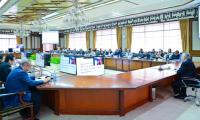Islamabad : The government has announced withdrawal of the 9% increase in prices of drugs—many of them essential life-saving medicines—which had been rendered beyond the reach of the common man due to an upward revision of between 50 to 75%, allowed on January 10, 2019. Moreover, drug prices raised by more than 75% will be stabilized at the level of 75% increase, and measures will be taken for implementation of reduction in prices of 395 drugs (notified vide SRO dated December 31, 2018), now that the Sindh High Court has disposed of petitions filed by pharmaceutical companies.
The PM’s Adviser on National Health Services Dr. Zafar Mirza announced these measures, which have already won approval of the Cabinet and the pharmaceutical industry, at a press conference here Thursday. He said, the measures will translate into both direct and indirect relief worth Rs10 billion to consumers, and regulations will follow within a couple of days for smooth implementation.
“Consumers will benefit directly because they will be able to purchase medicines at reduced prices, and they will benefit indirectly because the money that will be recovered from pharmaceutical companies which failed to reduce the prices of 395 drugs, as notified, will be deposited in the Baitul Mal fund for treatment of terminal diseases,” Dr. Zafar stated. A mechanism to enable such transfer will be devised in consultation with the Ministry of Finance. “Companies that are challenging the writ of the state will be prosecuted in Drug Courts and every penny of the overcharged amount will be recovered and spent on treatment of poor patients,” he assured.
Dr. Zafar added that following consultations with the pharmaceutical industry, consensus has been reached to the effect that since it is practically impossible to withdraw medicines (on which a further 9% increase had been made on the pretext of currency devaluation) and to recirculate them in the market with new prices, all new batches of those 464 medicines will have the revised retail prices printed on them. “Meanwhile, the industry has made a gentleman’s promise and will soon be advertising the prices of these medicines, alongside the timeframe within which these will be adjusted with a downward revision,” he added.
Referring to the category of medicines that will be priced at 75% increase, Dr. Zafar admitted that even though this percentage too may sound high, but because there has been zero increase in the prices of these medicines from 2002 to 2013, there was a strong possibility of the pharmaceutical companies halting production of these medicines, given the rising cost of production and the resultant lack of reasonable profit. “We have allowed the increase so as not to deprive patients of essential life-saving medicines,” he justified.
Dr. Zafar informed the media that he will be travelling to Lahore and Karachi after Eid to look into the issue of non-availability and short supply of cheap substitutes of essential life-saving medicines. Having spent more than two decades in the field, Dr. Zafar conceded that short-terms decisions will have to be replaced with a long-term perspective for which a National Medicines Policy will soon be framed. The pricing, quality and regulation of medicines; prohibition of over-the-counter sale of antibiotics; and incentivization of the pharmaceutical industry to increase their exports, among other issues; will be enshrined in the said policy.
Dr. Zafar said, upon completion of his 100 days as the PM’s Advisor on Health, he will submit a report chronicling his achievements. He also promised major reforms in hospitals as well as the Drug Regulatory Authority of Pakistan. He concluded that in spite of the frightful economic milieu that this government has inherited, the PM is continuously heard instructing ministers to take pro-poor measures. Dr. Zafar termed “lack of continuity in government policies” as the basic reason behind constant fluctuations—primarily upward revisions—in the prices of medicines.
People watch the Rawal Dam after the spillway opened due to heavy monsoon rain in Pakistan. — AFP/FileIslamabad:A...
Pakistani and Chinese national flags flutter next to an installation featuring a giant flower basket at Tiananmen...
A block of the National University of Science & Technology Islamabad. —National Science and Technology...
Minister of State for Information Technology and Telecommunications Shaza Fatima Khawaja addresses a ceremony at a...
Federal Directorate of Education building. — APP/File Islamabad: In a significant move to promote environmental...
IGP Islamabad Syed Ali Nasir Rizvi chairs a meeting on May 9, 2024. — Facebook/Islamabad Police The Inspector...







